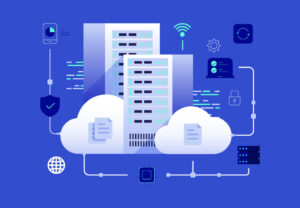Simplifying Multi-Account AWS Management with AWS Control Tower
“AWS Control Tower transforms multi-account AWS management through automated landing zone setup, centralised governance, and comprehensive security controls. Learn how this service streamlines cloud operations while ensuring compliance with organisational policies and industry regulations.”
Managing multiple AWS accounts is a complex task for large organisations. As cloud adoption accelerates, enterprises often operate dozens or even hundreds of AWS accounts, each serving distinct business units, projects, or environments. This proliferation of accounts poses significant challenges in maintaining consistent security policies, compliance standards, and operational practices across the organisation.
AWS Control Tower addresses these challenges by providing a comprehensive solution for establishing and governing a secure, compliant, multi-account AWS environment. Built on AWS best practices and extensive experience with thousands of enterprise customers, AWS Control Tower offers a streamlined approach to account management, security enforcement, and compliance monitoring. It eliminates the need for organisations to develop custom solutions for multi-account management, allowing them to focus on their core business objectives rather than cloud infrastructure governance.
For senior technology leaders and executives aiming to optimise their AWS cloud operations, AWS Control Tower represents a strategic investment in cloud governance. It can significantly reduce operational overhead while enhancing security posture and compliance capabilities. According to AWS, organisations using Control Tower have reported up to 30% reduction in operational costs and a 40% improvement in compliance adherence. [1]
Understanding AWS Control Tower
AWS Control Tower is a specialised service designed to facilitate the creation and management of a well-architected, multi-account AWS environment. At its core, AWS Control Tower setup automates the implementation of an AWS landing zone, which serves as the foundation for a secure and compliant AWS environment. This landing zone incorporates AWS best practices for account structure, identity management, federated access, and security controls.
The service operates by orchestrating multiple AWS services, including AWS Organisations, AWS Service Catalog, AWS IAM Identity Center (formerly AWS Single Sign-On), and AWS Config. By harmonising these services, AWS Control Tower creates a cohesive governance framework that can be applied consistently across all accounts within an organisation. This integration eliminates the need for technical teams to manually configure and maintain individual security and compliance tools, significantly reducing the risk of configuration errors and policy inconsistencies.
AWS Control Tower also provides a hierarchical structure for account organisation through AWS Organisations, allowing enterprises to group accounts based on business units, project teams, or compliance requirements. This structured approach enables granular policy application and permission management, ensuring that each account operates within the parameters defined by the organisation’s governance framework. The service’s automation capabilities extend to account provisioning, allowing organisations to create new accounts through a standardised process that applies the appropriate security controls and compliance checks automatically. [2]
Key Components of a Well-Architected Environment
A well-architected AWS environment built with AWS Control Tower setup incorporates several fundamental components designed to enhance security, compliance, and operational efficiency. Multiple AWS accounts serve as the primary building blocks, functioning as isolated resource containers that help organisations categorise workloads and limit the potential impact of security incidents. This segmentation approach confines potential threats to individual accounts, preventing lateral movement across the organisation’s cloud infrastructure. Additionally, separate accounts simplify billing analysis and resource attribution, allowing finance teams to accurately track costs and allocate expenses to specific business units or projects. [2]
Organisational Units (OUs) represent another critical component of the AWS Control Tower architecture. Leveraging AWS Organisations, AWS Control Tower allows administrators to arrange accounts into logical groupings based on common requirements or organisational structure. This OU-based hierarchy facilitates the application of consistent policies and controls at different levels of the organisation, ensuring that all accounts within a specific OU adhere to the same governance standards. For example, an organisation might create separate OUs for development, testing, and production environments, each with progressively stricter security and compliance requirements. [3]
The AWS Control Tower landing zone forms the foundation of the multi-account environment, providing a standardised starting point that aligns with AWS best practices. This landing zone includes pre-configured security accounts, such as an audit account for centralised logging and a security account for monitoring and compliance. The landing zone also establishes baseline security configurations, including AWS CloudTrail for activity logging, AWS Config for resource monitoring, and AWS IAM Identity Center for centralised identity management. By automating the setup of these foundational components, AWS Control Tower ensures that organisations begin their multi-account journey with a secure and compliant framework that can be extended and customised to meet specific business requirements. [1]
Benefits of a Multi-Account Strategy
Implementing a multi-account strategy through AWS Control Tower setup offers significant security advantages. Different applications and workloads often have distinct security requirements based on their sensitivity, regulatory obligations, and operational needs. By isolating these workloads in separate accounts, organisations can apply tailored security policies without compromising the posture of other environments. This approach also streamlines compliance and auditing processes, as security teams can focus their reviews on specific accounts that contain regulated data or critical applications, rather than sifting through all resources across the organisation. [1]
Account isolation provides powerful protection against the propagation of security threats. In a multi-account environment, compromised credentials or vulnerable resources in one account cannot easily affect resources in other accounts, as each account operates with its own permission boundaries and security controls. This containment approach significantly reduces the potential blast radius of security incidents, allowing organisations to quickly isolate and remediate affected resources without disrupting the entire cloud infrastructure. [4] The isolation principle extends to network resources, with each account maintaining separate VPCs and network configurations that can be connected through controlled channels when necessary. [5]
Team autonomy represents another key benefit of the multi-account approach. By assigning dedicated accounts to different teams or projects, organisations can grant development teams the freedom to innovate and experiment within their own environments without risking interference with other workloads. This delegation of authority reduces bottlenecks in resource provisioning and configuration management, allowing teams to operate with greater agility while remaining within the guardrails established by the central governance framework. [6] Teams can customise their resource allocation, networking configurations, and service selections to meet their specific requirements, fostering a culture of responsibility and ownership while maintaining organisational compliance through AWS Control Tower’s centralised governance mechanisms. [7]

Optimising AWS Control Tower for Secure Multi-Account Management
AWS Control Tower significantly simplifies the establishment and governance of multi-account architectures through its automated and integrated approach. The service ensures that organisations can rapidly deploy environments that adhere to AWS Control Tower best practices and meet regulatory requirements without extensive manual configuration. This standardisation reduces the risk of security gaps and compliance violations that commonly arise from inconsistent manual implementations across multiple accounts.
The automated landing zone setup process in AWS Control Tower represents a significant advancement over traditional manual approaches. Rather than requiring cloud architects to design and implement a landing zone from scratch, AWS Control Tower provisions a pre-configured environment that includes the necessary account structure, networking components, and security configurations. This automation accelerates deployment timelines from weeks or months to just hours, allowing organisations to quickly establish a secure foundation for their cloud workloads. The landing zone includes essential security accounts, such as an audit account that centralises logs from all accounts, enabling comprehensive visibility and analysis of activities across the organisation.
Guardrails form the pillar of AWS Control Tower’s governance capabilities, providing pre-configured rules that enforce compliance and security standards across all accounts. These guardrails operate at two levels: preventive controls that block non-compliant actions before they occur, and detective controls that identify and report on policy violations. Organisations can choose between mandatory guardrails, which cannot be disabled and enforce fundamental security practices, and elective guardrails that provide additional layers of protection based on specific requirements. This flexible approach allows organisations to implement a governance framework that balances security and compliance needs with operational flexibility, ensuring that cloud resources remain protected without unduly restricting legitimate business activities.
Benefits of Using AWS Control Tower
AWS Control Tower delivers substantial compliance benefits by establishing a consistent governance framework across all accounts. The service’s guardrails automatically enforce organisational policies and regulatory requirements, reducing the risk of non-compliance and potential penalties. Rather than relying on manual audits and remediation processes, security teams can leverage AWS Control Tower’s centralised dashboard to monitor compliance status across the entire organisation in real-time. When policy violations occur, AWS Control Tower provides detailed notifications and recommendations for remediation, allowing teams to quickly address issues before they escalate. This proactive approach to compliance management significantly reduces the burden on security teams while enhancing the organisation’s overall compliance posture. [4]
The scalability advantages of AWS Control Tower become particularly evident as organisations grow their cloud footprint. The service’s automated account provisioning and governance mechanisms allow enterprises to scale their AWS environments efficiently without compromising security or control. New accounts can be created through a standardised process that automatically applies the appropriate security controls and compliance checks, ensuring consistency across the organisation. As business units or projects require additional resources, AWS Control Tower facilitates the rapid expansion of the cloud environment while maintaining the necessary governance guardrails. This scalability extends to the management of organisational units, allowing administrators to create new OUs and apply appropriate policies as the organisation’s structure evolves. [8]
Effective cost management represents another significant benefit of implementing AWS Control Tower. The service’s integration with AWS Organisations enables centralised billing and cost allocation, providing finance teams with comprehensive visibility into cloud spending across all accounts. Organisations can implement cost allocation tags and budgets at the account level, allowing for precise tracking and attribution of expenses to specific business units, projects, or cost centres. Additionally, AWS Control Tower’s preventive guardrails can include cost-related policies, such as restrictions on expensive instance types or limitations on resource provisioning in certain regions, helping organisations avoid unexpected costs. [9]
By combining these cost management capabilities with AWS Control Tower’s governance framework, organisations can optimise their cloud spending while maintaining the necessary security and compliance standards. [10]
Security in AWS Control Tower
AWS Control Tower operates within the framework of AWS’s shared responsibility model, delineating security responsibilities between AWS and its customers. Under this model, AWS maintains responsibility for the security of the underlying cloud infrastructure, including physical data centres, network architecture, and the hypervisor layer. [2] This commitment to security is validated through regular third-party audits and compliance certifications, providing customers with assurance regarding the integrity of the AWS platform. [6] These validations span multiple regulatory frameworks, including SOC 2, ISO 27001, and various industry-specific standards [11], demonstrating AWS’s comprehensive approach to infrastructure security.
Customers retain responsibility for securing their workloads, data, and applications within the AWS environment. This includes configuring identity and access management policies, implementing encryption for data at rest and in transit, and establishing network security controls. [3] The scope of customer responsibility varies based on the AWS services utilised, with managed services reducing the operational security burden on customers. AWS Control Tower plays a crucial role in helping organisations fulfil their security responsibilities by providing automated tools and standardised configurations that align with AWS Control Tower best practices. [12]
AWS Control Tower enhances security through its comprehensive approach to configuration compliance. The service automatically establishes a landing zone that incorporates security best practices, ensuring that accounts are configured securely from the outset. [13] This initial configuration includes enabling AWS CloudTrail for comprehensive activity logging, configuring AWS Config for resource monitoring, and implementing AWS IAM Identity Center for centralised identity management. [4] AWS Control Tower also applies a set of foundational guardrails that enforce critical security policies, such as preventing the use of root account credentials and requiring encryption for sensitive data, [9] These automated configurations significantly reduce the risk of security vulnerabilities resulting from misconfiguration, which represents one of the most common causes of cloud security incidents. [14]
The service’s continuous governance capabilities provide ongoing protection against security drift. AWS Control Tower’s detective guardrails continuously monitor account configurations and resource deployments, alerting administrators when deviations from established policies occur. [15] This proactive monitoring allows security teams to identify and remediate potential security issues before they can be exploited. The service also provides detailed logging and audit trails, enabling security teams to conduct thorough investigations when incidents occur. [16] By integrating with other AWS security services, such as AWS Security Hub and Amazon GuardDuty, AWS Control Tower creates a comprehensive security ecosystem that provides multi-layered protection for cloud resources and data.

Advanced Automation and Cost Optimisation with AWS Control Tower
AWS Control Tower provides sophisticated integration capabilities with numerous AWS automation services, enabling organisations to establish highly efficient operational workflows. The service’s native integration with AWS Service Catalog allows enterprises to create standardised, pre-approved templates for resource provisioning across multiple accounts. [17] These templates ensure that new resources are deployed with consistent configurations that adhere to organisational standards and compliance requirements. Technical teams can leverage this capability to create self-service portals that empower developers to provision resources independently while maintaining governance guardrails, significantly reducing deployment bottlenecks and improving operational efficiency. [18]
Infrastructure as Code (IaC) automation represents another powerful capability within the AWS Control Tower setup. By integrating AWS Control Tower with AWS CloudFormation and AWS CDK (Cloud Development Kit), organisations can implement version-controlled, reproducible infrastructure deployments across their multi-account environment. [19] This approach enables sophisticated release pipelines that incorporate automated testing and validation before changes are deployed to production environments. AWS Lambda functions can be triggered by AWS Control Tower lifecycle events, such as account creation or policy changes, enabling automated configuration, security remediation, and custom guardrail implementation. [20] This event-driven architecture allows organisations to respond dynamically to changes in their environment, maintaining compliance and security posture without manual intervention. [21]
Cost optimisation becomes significantly more achievable through AWS Control Tower’s integration with AWS cost management services. [22] The service enables automated resource tagging strategies that provide granular visibility into cloud spending across all accounts. [23] By implementing standardised tagging policies through AWS Control Tower guardrails, organisations ensure consistent cost attribution and facilitate accurate chargeback mechanisms. [24] Integration with AWS Budgets allows the implementation of proactive cost controls, including automated notifications when spending approaches predefined thresholds and the ability to trigger automated actions to prevent budget overruns. [25] AWS Trusted Advisor recommendations can be centralised and implemented across multiple accounts through AWS Control Tower’s governance framework, allowing organisations to identify and address cost inefficiencies systematically. [26] Additionally, the service enables predictive scaling configurations through integration with AWS Auto Scaling, ensuring that resources are provisioned optimally based on forecasted demand patterns, further enhancing cost efficiency without compromising performance or availability. [27]
Conclusion
AWS Control Tower fundamentally transforms multi-account AWS management by automating the establishment of a secure and compliant landing zone, enforcing governance through customisable guardrails, and providing centralised visibility and control. This comprehensive approach enables organisations to scale their cloud environments efficiently while maintaining consistent security and compliance standards across all accounts. Motherson Technology Services leverages AWS Control Tower to accelerate clients’ migration to AWS, ensuring security and compliance from day one. Our expertise in customising AWS Control Tower implementations to meet specific industry and regulatory requirements allows clients to balance governance and operational flexibility, supporting their business objectives.
Organisations adopting AWS Control Tower through Motherson Technology Services gain a competitive advantage by reducing operational overhead, enhancing security posture, and streamlining compliance management. This approach allows technical teams to focus on innovation rather than routine governance tasks, reduces the risk of breaches, and demonstrates regulatory adherence more efficiently. As cloud environments grow in complexity, effective multi-account AWS governance becomes increasingly important. AWS Control Tower, implemented with Motherson’s expertise, provides the tools and frameworks needed for efficient, secure, and compliant cloud governance, positioning organisations for sustainable growth and innovation in a cloud-centric business landscape.
References
[1] https://docs.aws.amazon.com/controltower/latest/userguide/aws-multi-account-landing-zone.html
[2] https://docs.aws.amazon.com/controltower/latest/userguide/best-practices.html
[3] https://docs.aws.amazon.com/prescriptive-guidance/latest/aws-control-tower/best-practices.html
[4] https://aws.amazon.com/controltower/
[6] https://docs.aws.amazon.com/controltower/latest/userguide/security.html
[7] https://k21academy.com/amazon-web-services/aws-control-tower/
[8] https://docs.aws.amazon.com/controltower/latest/controlreference/compliance.html
[9] https://docs.aws.amazon.com/controltower/latest/userguide/what-is-control-tower.html
[10] https://dev.to/aws-builders/why-you-should-use-aws-control-tower-fb0
[11] https://aws.amazon.com/blogs/mt/best-practices-for-applying-controls-with-aws-control-tower/
[12] https://docs.aws.amazon.com/controltower/latest/controlreference/security-hub-controls.html
[13] https://docs.aws.amazon.com/controltower/latest/userguide/config.html
[14] https://aws.amazon.com/compliance/shared-responsibility-model/
[17] https://docs.aws.amazon.com/controltower/latest/userguide/integrated-services.html
[18] https://docs.aws.amazon.com/controltower/latest/userguide/automating-tasks.html
[20] https://aws.amazon.com/blogs/architecture/category/management-tools/aws-trusted-advisor/
[22] https://docs.aws.amazon.com/organizations/latest/userguide/services-that-can-integrate-CTower.html
[24] https://docs.aws.amazon.com/controltower/latest/userguide/service-catalog.html
[25] https://docs.aws.amazon.com/controltower/latest/userguide/provision-as-end-user.html
[26] https://aws.amazon.com/marketplace/solutions/control-tower/cost-management-and-governance
[27] https://aws.amazon.com/marketplace/solutions/control-tower/
About the Author:

Dr. Bishan Chauhan
Head – Cloud Services & AI / ML Practice
Motherson Technology Services
With a versatile leadership background spanning over 25 years, Bishan has demonstrated strategic prowess by successfully delivering complex global software development and technology projects to strategic clients. Spearheading Motherson’s entire Cloud Business and global AI/ML initiatives, he leverages his Ph.D. in Computer Science & Engineering specializing in Machine Learning and Artificial Intelligence. Bishan’s extensive experience includes roles at Satyam Computer Services Ltd and HCL prior to his 21+ years of dedicated service to the Motherson Group.

 April 28, 2025
April 28, 2025 Dr. Bishan Chauhan
Dr. Bishan Chauhan















































